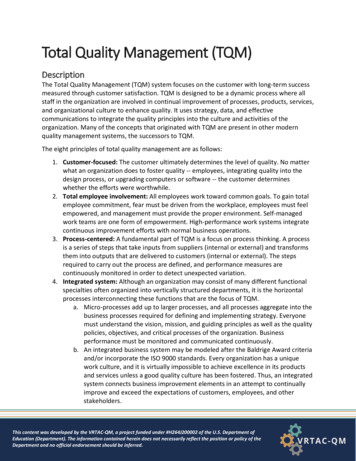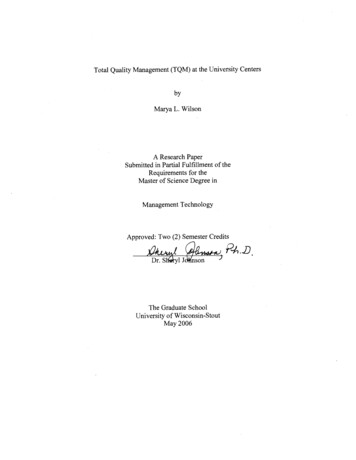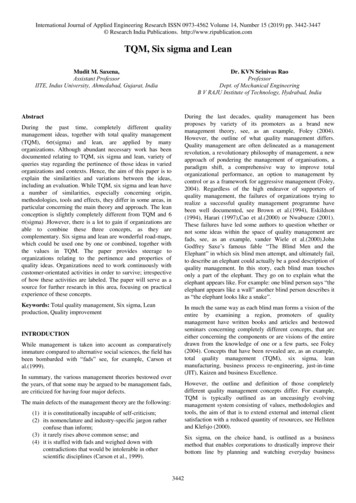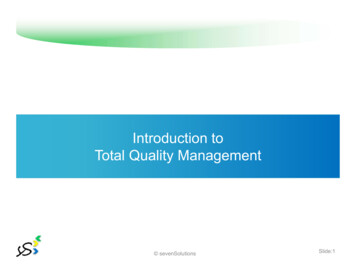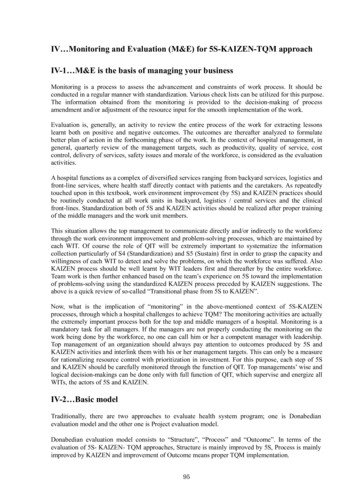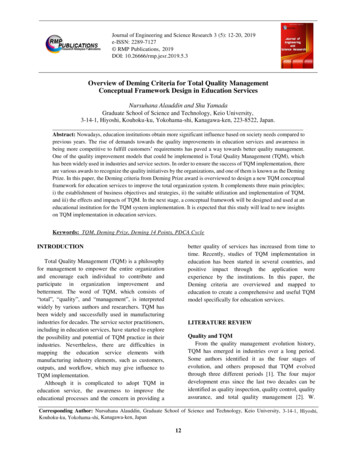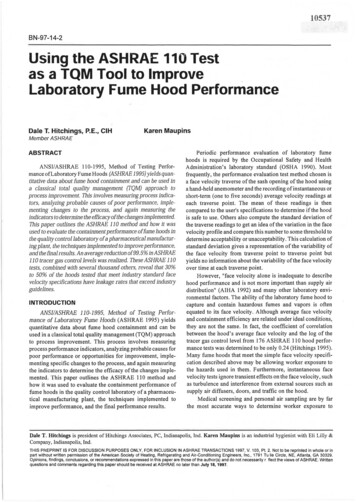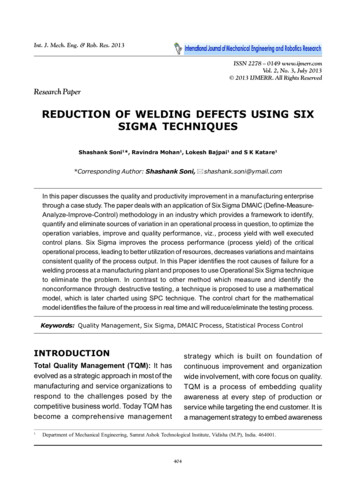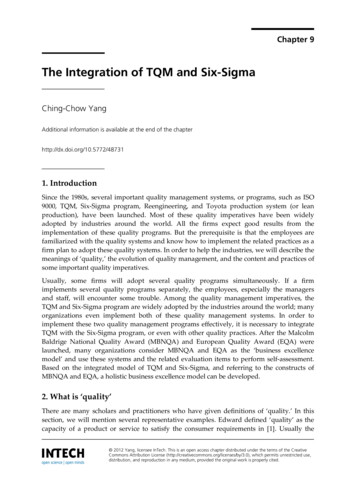
Transcription
Chapter 9The Integration of TQM and Six-SigmaChing-Chow YangAdditional information is available at the end of the chapterhttp://dx.doi.org/10.5772/487311. IntroductionSince the 1980s, several important quality management systems, or programs, such as ISO9000, TQM, Six-Sigma program, Reengineering, and Toyota production system (or leanproduction), have been launched. Most of these quality imperatives have been widelyadopted by industries around the world. All the firms expect good results from theimplementation of these quality programs. But the prerequisite is that the employees arefamiliarized with the quality systems and know how to implement the related practices as afirm plan to adopt these quality systems. In order to help the industries, we will describe themeanings of ‘quality,’ the evolution of quality management, and the content and practices ofsome important quality imperatives.Usually, some firms will adopt several quality programs simultaneously. If a firmimplements several quality programs separately, the employees, especially the managersand staff, will encounter some trouble. Among the quality management imperatives, theTQM and Six-Sigma program are widely adopted by the industries around the world; manyorganizations even implement both of these quality management systems. In order toimplement these two quality management programs effectively, it is necessary to integrateTQM with the Six-Sigma program, or even with other quality practices. After the MalcolmBaldrige National Quality Award (MBNQA) and European Quality Award (EQA) werelaunched, many organizations consider MBNQA and EQA as the ‘business excellencemodel’ and use these systems and the related evaluation items to perform self-assessment.Based on the integrated model of TQM and Six-Sigma, and referring to the constructs ofMBNQA and EQA, a holistic business excellence model can be developed.2. What is ‘quality’There are many scholars and practitioners who have given definitions of ‘quality.’ In thissection, we will mention several representative examples. Edward defined ‘quality’ as thecapacity of a product or service to satisfy the consumer requirements in [1]. Usually the 2012 Yang, licensee InTech. This is an open access chapter distributed under the terms of the CreativeCommons Attribution License (http://creativecommons.org/licenses/by/3.0), which permits unrestricted use,distribution, and reproduction in any medium, provided the original work is properly cited.
220 Total Quality Management and Six Sigmaconsumer’s wants are complex and multi-faceted, thus it may not always be satisfied in aparticular way. Juran defined quality as being ‘fitness for purpose of use, , it is judged bythe users, not the manufacturers, or the merchants’ in [2]. Juran also asserted that eachproduct/service has multiple quality characteristics, which can be divided into two kinds:the features desired by customers, and the freedom from deficiencies. Thus Crosby definedquality as ‘conformance to customers’ requirements’ from the viewpoint of the customers,he also emphasized the ideal of ‘zero defects’ or ‘meeting all the specifications ofproduct/service all the time’ in [3].The definitions mentioned above are not mutually exclusive, they are almost the same.There are several researchers who have given similar definitions, for examples, see [4, 5, 6].Japanese Industrial Standard (JIS Z8101) and International Standard Organization (ISO8402-1986) give the same definition of ‘quality’ as the totality of features and characteristicsof a product/service which determines the ability to satisfy the customers’ needs andexpectations in [7]. Thus, the providers of products/services need to determine thespecifications upon these features and characteristics which can meet the customers’requirements and expectations.There are some critical concepts of quality to be emphasized. Japanese quality philosophy is‘zero defects - doing it right the first time.’ It means that quality is the result of doing theright thing and doing the thing right the first time, ‘doing the right thing’ is to meet thecustomers’ needs and expectations, and doing the thing right’ is to follow the standards ofthe totality of quality. The definition of quality by Crosby has the same concept. Deming’squality concept is customer-focused; he emphasized that quality is only assessed bycustomers; the quality is surpassing customers’ needs and expectations throughout thelifetime of product/service in [5, 8].We can summary the meanings of quality as follows.1.2.3.4.5.6.7.Quality is conforming to the standards and specifications of a product/service.Quality is zero defects or meeting the specifications 100%.Quality means that product/service possesses the fitness for purpose of use based on itsfunctions.Quality is the ability of a product/service to meet the customer’s needs andexpectations.Quality is assessed by customer only borne upon the critical features and characteristicsof a product/service considered by customer.Quality is determined by the deviation of the measures of quality characteristics of aproduct.Quality is customer satisfaction.3. The evolution of quality managementQuality, price, product function, delivery, and reliability are the competitive aspects for anyindustries, of which quality has become the most important one in [9] since customers only
The Integration of TQM and Six-Sigma 221buy the goods with accepted quality. In order to assure the delivery of good qualityproducts to customers, industries have adopted many actions to control the quality of theproducts during the manufacturing process. These actions are somewhat different due tothe change of the quality concept. In the beginning, the major quality concepts wereproduct-focused and manufacturing-focused and then changed to user-focused, customerfocused, and value-focused. The evolution of quality management is coincidental with thechange of quality-focused, which consists of several stages.3.1. Inspection quality control (IQC), since 1910 Ford Company created the assembly line in 1913 due to the influence of the scientificmanagement of Frederick W. Taylor. The implementation of the assembly line led Ford toreduce manufacturing costs significantly. Therefore the assembly line and the resultingvolume production became very popular among the manufacturing industries. But it causedthe issue of quality control. In this period, inspection activities were formally recognized asthe popular control of product quality in [10]. In most manufactures, the foremen areresponsible for the inspection works. Thus, it is also called foreman quality control.Engineers and management level design the standards of the quality upon the criticalattributes of the product, and set up the process standards and the related taskspecifications. Workers are requested to perform the tasks according to the standards andspecifications. The inspectors will check the dimensions and characteristics of products,detect the errors and failures, and take the necessary steps to improve the quality.3.2. Statistical process control (SPC), since 1930 Inspection quality control is costly since it fails to effectively control the process quality.Walter Shewhart thus created the quality control tool ‘control chart’ as he had worked inBell Labs as a quality control inspector in [11]. He suggested using a sampling inspectionmethod instead of 100 percent inspection to reduce the amount of inspection, due to hisstudy of chronic variation of production. The control chart is used to monitor the qualityperformance of the process by using the sampling methods upon the critical aspects of theprocess and the attributes of the product in [10].Since many statistics tools are used in the statistical process control, we also call the qualitycontrol method ‘statistical quality control (SQC)’ Using sampling inspection will causefewer defective products to be shipped and result in some extra costs, but Shewhart arguedthat if the missed number of defects is small, then the savings in inspection costs make itworthwhile in [11].3.3. Total quality control (TQC), since 1950 Starting in the early 1950s, J. M. Juran propounded the concept of quality costs. Headdresses the economics of quality in the book ‘Quality Control Handbook’ in 1951 in [9]. Itis often that the losses due to defects were more than the costs of quality control. Thus the
222 Total Quality Management and Six Sigmamodel of ‘costs of quality,’ which is subdivided into prevention, appraisal, internal failureand external failure costs, is proposed. The way of SPC can’t effectively reduce the qualitycosts, especially the costs caused by internal failures and external failures.Armand Feigenbaum joined General Electric since 1944 in [9]. He used the statisticaltechniques to improve the product quality while he was working in the jet engine factory.But Feigenbaum also used the concept of cost-of-quality and adopted a user-based approachto quality. He thought that this approach requires the management and employees to havean understanding of what quality means and its relation to the company’s benefits. Heemphasized that quality assurance cannot be achieved by the control just on productionprocess. Thus he propounded the concept of Total Quality Control in 1956 in [12]. Thismeans that the quality is determined at all stages of the whole product lifetime, and all thefunctions are included in the quality control. The quality activities start with the productdesign, incoming quality approval, and continue through production control, productreliability, inventory, delivery, and customer service. Actually, Feigenbaum’s qualityconcept and ideas are similar to those described by Deming, Juran, and Crosby in [12].3.4. Company-wide quality control (CWQC), since 1970 After World War II, the Union of Japanese Scientists and Engineers (JUSE) was formed in1946. Its members were constituted of scholars, engineers, and government officials in [13].They devoted themselves to improving Japanese productivity and product quality in orderto enter the foreign markets, especially the American market. In 1950, JUSE invited Demingto Japan to introduce the quality concepts and statistical quality methods to the topmanagers of Japanese industries in [11]. Juran also visited Japan in 1954 and instilled theconcepts of quality control, costs of quality, and the strategic role of management in thequality activities for the Japanese industries in [11]. The concept and approach of TQC wereintroduced to Japan during 1960. JUSE synthesized the concepts, principles, and approachesof statistical process control and total quality control.During this period, Japanese industries realized the concepts of TQC. All the departmentsand employees, from the operators, first-line supervisors, engineers, managers, and topmanagements, participated in the quality programs and activities. Thus, we called thisJapanese TQC company-wide quality control (CWQC). Japanese industries emphasized theeducation and training of quality for all employees and the cultivation of quality cultureintensively. Kaoru Ishikawa, a pioneer in quality control in Japan, advocated the use ofstatistical methods. But his largest contribution was to promote the realization of totalquality and continuous improvement. He contrived the Quality Control Circle (QCC)activity, and used the seven QC tools and improvement tools to apply the QCCimprovement activities in [9].3.5. Total Quality Management (TQM), since 1985 The realization of CWQC led Japanese industries to possess core competitiveness andquickly move into western markets that were once dominated by western companies by
The Integration of TQM and Six-Sigma 223providing the customers with high quality products at lower prices in [14]. The westernfirms, especially the American companies, encountered serious global competition fromJapanese and Asiatic competitors. The western companies saw their shares eroded byforeign competitors. This situation caused American and western industries to benchmarkJapanese CWQC performance and learned the management of quality control from Japan.As a result, total quality management (TQM) was developed and widely adopted by theindustries around the world. The industries considered TQM as a powerful tool that can beused to regain the competitive advantage.The development of TQM was also influenced by the western quality gurus: Deming, Juran,Feigenbaum, and Crosby in [15]. TQM is thus an integrated model of managementphilosophy, quality concept, and set of practices. However, to implement the TQMsuccessfully it is necessary to integrate the so-called ‘hard side’ of the system (that is, thetechnical aspects of quality control) with the ‘soft side’ of the program (that is, the aspectsassociated with ‘quality concept, culture, and people factors’) in [16]. Statistical methods,quality control tools, process standardization, and improvement are the elements of ‘hardside,’ and quality concept, employees’ participation, education and training, and qualityculture are included in the ‘soft side.’From the mid-1990s onward, several important quality programs were being launched.Besides the development of TQM, the ISO system and Six-Sigma program, which wasinitiated by Motorola, were started in 1987. Until now, ISO system has had three revisions in1994, 2000, and 2008 respectively. The Six-Sigma program was being widely imitated by GEin 1995 in [17], while most were copying from Motorola. The successful implementation ofSix-Sigma by Motorola and GE caused this improvement methodology to become popularlyadopted by the industries around the world.3.6. Business Excellence Model, since 2000 The rapid development and application of technology and internet have caused significantchanges in market environments in [18, 19] and, consequently, in business management in[15]. In particular, the effects of the borderless global economy are clearly evident invirtually every aspect of business activity in [20]. The increased competitive pressure fromboth domestic and forei gn competitors has forced businesses to pursue speed, innovation,quality, and value in [21, 15]. In the past two decades, the industries adopted severalstrategic actions: Total Quality Management (TQM), ISO system, Reengineering, Six-Sigmaprogram, Toyota production system (TPS), etc. in [22, 15]. But in today’s world of seriouscompetition, implementing these actions may not be enough to possess the competitiveness.The enterprises need to develop their core competencies and core capabilities in order toexcel at the contrivance of core competitiveness and then develop the innovative businessmodel in [23-27]. The integrated system of these critical ingredients, in order to pursue thelong-term high profits and development, can be called a business excellence model. Butthere is no coincidence of the formal ‘business excellence model.’ Several scholars andpractitioners consider the model of Malcolm Baldrige National Quality Award (MBNQA) or
224 Total Quality Management and Six Sigmathe model of European Quality Award (EQA) as the ‘business excellence model’ in [9]. Kanjideveloped a business excellence model that was suitable for organizations that incorporatethe critical success factors of TQM in [28]. Based on this business-excellence model, Kanjithen developed a ‘business scorecard’ in [28]. Kanji & SÂ later developed a ‘Kanji businessexcellence measurement system’ by integrating the business excellence model and Kanji’sbusiness scorecard in [29]. Yang also developed an integrated model of a business excellencesystem in [30].4. The development and implementation of TQMTQM began in the mid-1980s and was based on benchmarking and learning from JapaneseCWQC. In the beginning, there was a lack of consensus on the content and practices ofTQM. But several gurus, like Deming, Juran and Ishikawa have contributed much to thedevelopment of TQM, especially the Deming 14 points and Juran quality trilogy in [31, 9,32]. Additionally, the characteristics of CWQC also affected the content of TQM.4.1. The fundamental concepts of TQMNow we state the concepts, practices, and characteristics as follows.4.1.1. Deming 14 points:1.2.3.4.5.6.7.8.9.10.11.12.13.14.Create constant purpose toward quality improvement of products and service.Adopt the new concept of ‘zero defect’ that we no longer accept the commonly acceptedlevels of delays, mistakes, and defective products.Stop the dependence on mass inspection of quality control to achieve the qualityassurance; instead, set up the built-in quality system in the production processes.Cease the practice of material purchases based on the decision of the price alone.Use statistical methods to find the root causes of the problems and ultimately eliminatethese problems.Institute modern methods and systems of employees’ on-job training.Execute new methods of leadership for the supervision of workers.Drive out fear, so that every employee can work effectively.Break down barriers between departments; instead, team-work can be realized.Eliminate slogans and the exhortations by numerical goals for the workforce; instead,encourage employees to challenge high levels of quality and productivity.Eliminate only work quotas without accounting quality and remove the obstacles thatprevent employees from achieving their challenge.Remove barriers that rob people of their pride of workmanship.Develop and execute a complete program of education and training for all employees.Perform all above actions and push for continuous improvement.4.1.2. Juran quality trilogyJuran divided quality management system into three stages, which are
The Integration of TQM and Six-Sigma 2251.Quality planning:The firms first identify the focused customers and their needs and set up the goals to satisfycustomers and achieve excellent business results based on the development of new productsand strategic processes. This planning stage also attempts to eliminate problems which maybecome chronic as the process was designed that way.2.Quality control:The firms need to establish a control system to monitor the quality, evaluate the processperformance, and compare the operating results with the goals. It is also critical to discoverthe problems, especially the chronic problems.3.Quality improvement:In this stage the firms will identify the improvement projects and teams and analyze the rootcauses and eliminate them. After the problems are solved, the firms will standardize thenew process and establish the mechanisms to control the new process in order to assure thequality.4.1.3. Characteristics of CWQC:1.2.3.4.5.6.7.8.9.Customer-focused and quality-first.Full participation and teamwork.Education and training of quality for all employees.Cultivation of quality culture.‘Continuous improvement’ is the key quality activity.Concept and realization of ‘zero defect.’Realization of ‘do the right thing first time.’Everyone is responsible for the quality.Emphasizing on the prevention activities and quality assurance.4.2. The content and framework of TQMDuring this period, the ISO 9000 quality system was launched and Motorola implementedSix-Sigma improvement projects in 1987. The USA also started the Malcolm BaldrigeNational Quality Award (MBNQA) in 1987, which was based on the referring to theJapanese Deming Award. After MBNQA launched, many countries also developed theirnational quality awards based on the MBNQA system. The development of TQM isdisplayed in Figure 1.Additionally, many researchers and experts on quality management have been eager tostudy the essentials of TQM. The development and implementation of TQM today hasbecome a very consistent consensus on the content in [33, 34, 15] as follows:1.Customer focus – To understand the requirement of customers proactively, take properactions to fulfill the customers’ needs, and the aim to satisfy customers.
226 Total Quality Management and Six Sigma2.3.4.Continuous improvement – To discover problems, analyze the critical root causes, andeliminate those barriers completely.Employees’ participation – Every employee is accountable with one’s responsibility forquality, and also everyone needs to be involved and commit oneself to every qualityactivity.Teamwork–It is necessary to overcome sectionalism and to realize the teamwork andcooperation for improving quality and embark on quality activities.StartingFormingExtending From TQC to CWQC, to TQM TQM is starting from 1980s TQM, ISO, and Motorola-6σ in 1980s Deming’s fourteen points The Juran trilogy From Deming Award to the MalcolmBaldrige National Quality AwardFigure 1. The development of TQM5.Process focus – Standardizing the processes and taking proper quality control in the keysteps of the operation procedures to prevent any defects occurring in processes.6. Systemization – For bettering the prevention and control of quality, all the qualityactivities should be conducted and implemented systematically.7. Empowerment – It is critical that every employee can be autonomous to do the rightthing the first time in order to get good quality performance. Therefore, it is necessaryto empower the employees.8. Leadership – During the implementation process of TQM, the top management shouldplay a key role. The top management should be a coach, to teach and influence thesubordinates.9. Management by facts – For the sake of quick decision and solving problems, it isnecessary to use numerical methods and statistical tools effectively. It is also essential todevelop the quality information system and powerfully apply this system.10. Training and education – Japanese industries emphasize the training and education forthe employees, which is focused on the quality concepts and the improvement tool, and
The Integration of TQM and Six-Sigma 227the implementation of quality practices. Thus, employee training and education is thefundamental activity for the adoption of TQM.11. Corporate quality culture – In order to successfully perform the above imperatives, thetop management needs to cultivate the organization quality culture, and all theemployees can maintain it forever.To understand and fulfillcustomers requirementsCustomer SatisfactionSurvey and quality auditProcess standardizationand managementDaily management andempowermentThe management andleardershipThe change and reformingof organizational cultureEmployees educationand trainingSetting managementprinciples and quailty policiesManagement's commitmand achieving a consensFull participationContinuous improvementInstilding the correctiveconcepts of qualityThe realization of teamworkEmployees satisfaction andcustomers satisfactionFigure 2. The framework of the implementation of TQMBased on these imperatives, we can develop the framework of the implementation of TQM,see Figure 2.5. The development and implementation system of Six-Sigma programThe Six Sigma program was first espoused by Motorola in the mid-1980s. The Six Sigmaarchitects at Motorola produced results far more rapidly and effectively. The successfulimplementation of the Six Sigma program in Motorola led to several famous companiesfollowing Motorola in successfully implementing the Six Sigma program in [17]. In thissection, we first introduce the development of Six-Sigma program.5.1. The development of Six-Sigma programBy the end of the 1970s, Japanese industries possessed strong competitiveness; theircompetitiveness was based on the ability to develop the core competencies with lower costs,higher quality, and greater speed than their competitors, which could be utilized to contrivethe core products. The core competence is the effective integration of technologies,
228 Total Quality Management and Six Sigmaspecialized knowledge, skills, techniques, and experiences, and the core capability is theunique management ability of core competencies to develop core products and newbusiness and then enter the new markets. Eventually, the firms will heighten theircompetitive advantage and result in business benefits and long-term development, whichwill exceed their competitors’ in [35, 25].In this period, Motorola encountered intense competition from their global competitors,especially from the Japanese competitors. The threats caused Motorola to execute thebenchmarking from the Japanese electronics industry and found out that many Japaneseelectric products were with 6σ quality level, but Motorola’s products were with 4σ qualitylevel only. The weakness in quality led Motorola to initiate the Six-Sigma improvementprograms. The aim was to achieve 6σ quality level in a 5-year period. The Six Sigmaarchitects at Motorola focused on making improvements in all operations within a process—thus producing results far more rapidly and effectively.The successful implementation of the Six Sigma program in Motorola resulted in hugebenefits. Motorola recorded a significant reduction in defects and manufacturing time andalso began to reap financial rewards. Within four years, the Six Sigma programs saved thecompany 2.2 billion in [36]. The crowning achievement for Motorola occurred when it wasthe winner of the Malcolm Baldrige National Quality Award in 1988 in [37]. IBM, Sony, andAllied Signal followed Motorola in successfully implementing the Six Sigma program.Allied Signal began its Six Sigma activities in the early 1990s and attained savings of US 2billion during a five-year period in [37]. Such impressive results induced General Electric(GE) to undertake a thorough implementation of the Six-Sigma program (GE-6σ) since 1995in [17].GE implemented 6σ programs and reaped huge financial benefits. The 1999 annual report ofGE showed that the implementation of GE-6σ produced more than US 2 billion in benefitsin that year in [38]. The impressive benefits of implementing a Six Sigma program inMotorola, Allied Signal, and GE led to the Six Sigma methodology being widely adopted byindustries and non-profit organizations throughout the world. Within a short time, the SixSigma program thus became one of the world’s most important tools in quality managementin the last two decades.5.2. The implementation system of Six-Sigma programThe huge contribution of the implementation of the Six-Sigma program is due to therealization of better practices and operation systems. In the initiative stage, Motorola andGE designed a complete implementation system. The main features of the system arediscussed below under the following headings:1.2.3.Implementation steps;The support from organization;Investment in training.
The Integration of TQM and Six-Sigma 2291.Implementation stepsThere have been many improvement models for process improvement or re-engineering.Most of their implementations are based on the steps introduced by W. Edwards Deming,which can be characterized as ‘Plan,’ ‘Do,’ ‘Study,’ and ‘Act’ (PDSA) in [39]. The Six-Sigmaprogram has a five-phase cycle: ‘Define,’ ‘Measure,’ ‘Analyze,’ ‘Improve,’ and ‘Control’(DMAIC) for process improvement that has become increasingly popular in Six Sigmaorganizations. There is another cycle characterized as ‘Define,’ ‘Measure,’ ‘Analyze,’‘Design,’ and ‘Verify’ (DMADV) for process design (and redesign) in [17]. Like otherimprovement models, the DMAIC (or DMADV) model is grounded in the original DemingPDCA cycle. Table 1 describes the specific tasks in each step, and the tools and techniquesused in the DMAIC steps. The tasks and tools used in the DNADV steps are similar to thoseused in the DMAIC steps.StepDefine Measure Analyze ImproveControl Specific tasksAnalyze voice of customers (VOC)Identify improvement issuesOrganize project teamSet-up improvement goalEstimate financial benefit Map process and identify inputs and outputs Establish measurement system for inputs and outputs Understand the existing capability of processIdentify sources of variation inprocessIdentify potential critical inputsDiscover the root causesDetermine tools used in theimprovement stepCreate the strategic actions toeliminate the root causesConduct improvement actionsUse experimentsOptimize critical inputsStandardize the processMaintain critical inputs in theoptimal areaVerify long-term capabilityEvaluate the results of improvementprojectsTable 1. DMAIC steps and tools usageTools and techniques employedCustomer complaint analysisCost of poor quality (COPQ)BrainstormingRun charts, control chartsBenchmarkingProcess map (SIPOC)Cause and effect matrixGauge R&RControl chartsProcess capability analysisFailure models and effectsanalysis (FMEA) Cause-and-effect diagramPareto diagramScatter diagramBrainstormingAnalysis of variance (ANOVA) Design of experiment (DOE)Quality function deployment(QFD)Process capability analysisControl chartsStandard operation procedureProcess capability analysisFool-proofing (Poka Yoke)Run chartsFailure models and effectsanalysis (FMEA)
230 Total Quality Management and Six Sigma2.The supports from organizationAlong with the systematic implementation steps described above, the design of specificroles and their effective operations are important factors of the Six-Sigma program. Topmanagement is ultimately responsible for the success of the projects through the provisionof sufficient support, resources, and strong leadership. The implementation of the Six-Sigmaprogram is thus top–down. The chief executive officer (CEO) is usually the driving forcewho sets up the vision, develops the strategies, and drives the changes. Apart from thecritical role of the CEO, other players also have their specific roles: (i) the senior managersare the ‘Champions,’ who are the sponsors of the projects and responsible for success of SixSigma efforts; (ii) the ‘Master Black Belts’ (MBBs) are the full-time teachers and consultants;(iii) the ‘Black Belts’ (BBs) have the key operational role in the program as full-time SixSigma players. They are the leaders of the Six-Sigma improvement projects, an
TQM and Six-Sigma program are widely adopted by the industries around the world; many organizations even implement both of these quality management systems. In order to implement these two quality management programs effectively, it is necessary to integrate TQM with the Six-Sigma program
